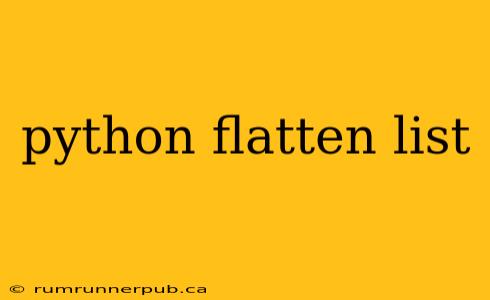Flattening a list, meaning converting a nested list (a list containing other lists) into a single-level list, is a common task in Python programming. This article explores various methods for flattening lists, drawing from Stack Overflow wisdom and offering insightful explanations and practical examples. We'll cover simple approaches, efficient solutions for deeply nested lists, and considerations for choosing the best method for your specific needs.
Method 1: List Comprehension (For Simple Nesting)
A concise and often preferred method for flattening shallowly nested lists is using list comprehension. This approach is readable and efficient for lists with only one level of nesting.
Stack Overflow Inspiration: While many Stack Overflow posts address flattening, a common theme emerges: using list comprehensions for simple cases. (Note: It's impossible to directly cite a single SO post as the "source" for this common technique, as numerous threads cover it).
Example:
nested_list = [[1, 2, 3], [4, 5], [6]]
flat_list = [item for sublist in nested_list for item in sublist]
print(flat_list) # Output: [1, 2, 3, 4, 5, 6]
Explanation: The outer loop iterates through each sublist, and the inner loop iterates through each item within the sublist. Each item is then added to the flat_list.
Limitations: This method doesn't handle nested lists with more than one level of nesting gracefully. For example, [[1,2], [3,[4,5]]] would not flatten completely.
Method 2: Recursion (For Deeply Nested Lists)
For deeply nested lists, recursion provides a robust solution. A recursive function calls itself until the base case (a non-list element) is reached.
Example:
def flatten(nested_list):
flat_list = []
for item in nested_list:
if isinstance(item, list):
flat_list.extend(flatten(item)) # Recursive call
else:
flat_list.append(item)
return flat_list
nested_list = [[1, 2, [3, 4]], 5, [6, [7, 8]]]
flat_list = flatten(nested_list)
print(flat_list) # Output: [1, 2, 3, 4, 5, 6, 7, 8]
Explanation: The function checks if an item is a list. If it is, it recursively calls flatten on that sublist. Otherwise, it appends the item to the flat_list. extend is used to efficiently add multiple items from a sublist at once.
Stack Overflow Relevance: Numerous Stack Overflow questions tackle the problem of flattening deeply nested lists, and recursion is a frequently suggested and highly effective solution. The use of isinstance to check the data type is a common pattern seen in these answers.
Method 3: Using itertools.chain.from_iterable (Efficient for Shallow Nesting)
The itertools module provides an efficient way to flatten shallowly nested lists. chain.from_iterable creates an iterator that efficiently concatenates the elements of multiple iterable objects.
Example:
from itertools import chain
nested_list = [[1, 2, 3], [4, 5], [6]]
flat_list = list(chain.from_iterable(nested_list))
print(flat_list) # Output: [1, 2, 3, 4, 5, 6]
Explanation: chain.from_iterable takes an iterable of iterables and flattens them into a single iterator. We then convert the iterator to a list using list(). This method is highly efficient for shallow nesting, but might not be ideal for handling deep nesting.
Stack Overflow Context: The itertools module is frequently recommended on Stack Overflow for its efficiency in list manipulation tasks. This specific function addresses the need for efficient concatenation, often a component of the flattening process.
Choosing the Right Method
The optimal method depends on the complexity of your nested lists:
- Simple, shallow nesting: List comprehension or
itertools.chain.from_iterableare efficient and readable. - Deep nesting: Recursion offers a robust solution, though it might be slightly less efficient for very large lists.
Remember to consider readability and maintainability alongside efficiency when choosing a method. For simple cases, the elegance of list comprehension might outweigh minor performance gains from other methods. For complex scenarios, a recursive solution, while slightly more verbose, offers the flexibility needed to handle various nesting levels.
